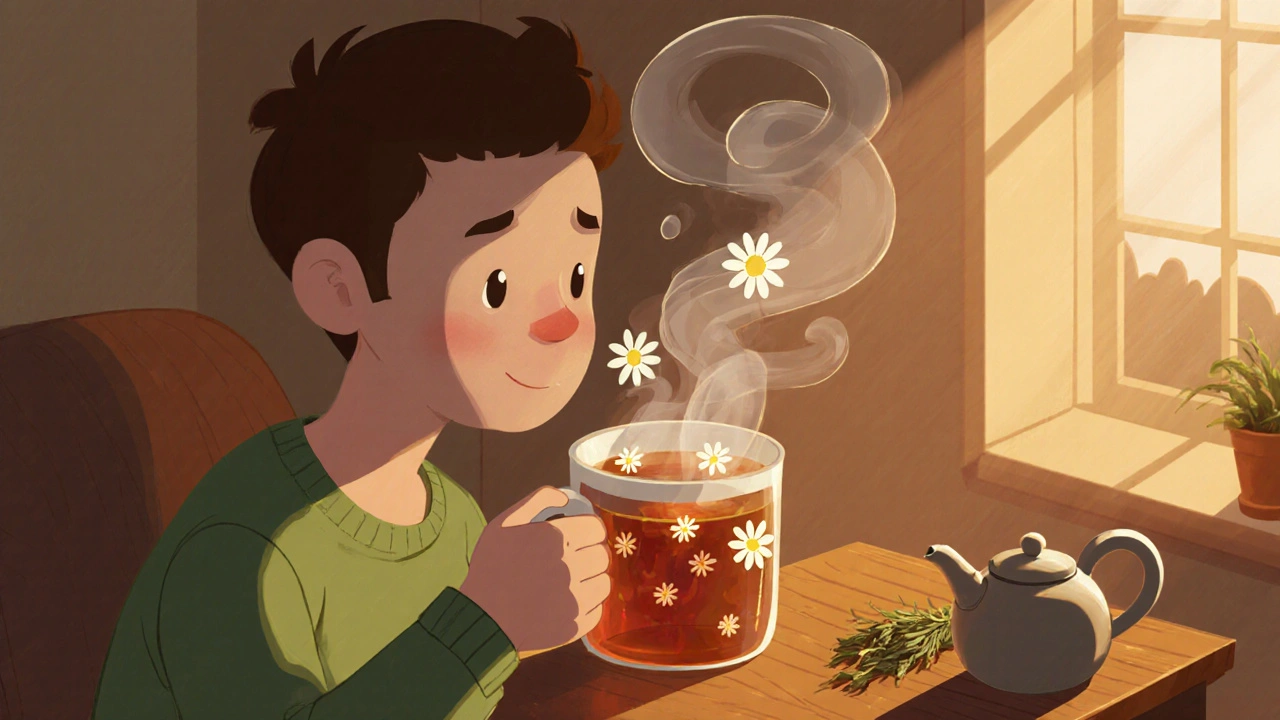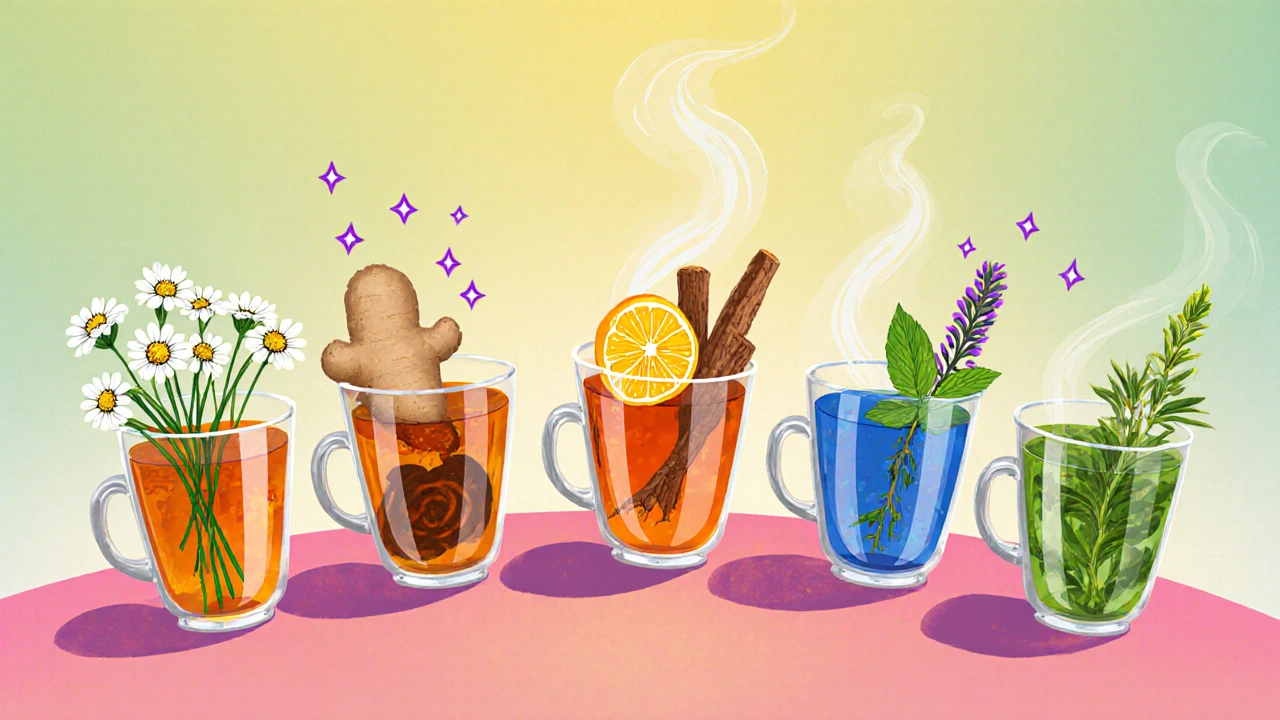
Select your primary sore throat symptom to get personalized herbal tea recommendations.
Gentle anti-inflammatory & calming
Chamomile is ideal when you need gentle relief from inflammation and irritation. Its anti-inflammatory compounds help reduce swelling while its calming properties ease discomfort.
Brewing tip: Steep for 5-7 minutes to maximize benefits. Add a drizzle of honey for extra soothing effect.
When a scratchy sore throat hits, reaching for a cup of something warm feels instinctive. But not every warm drink offers the same soothing power. herbal teas bring a blend of hydration, heat, and plant compounds that can calm irritation, reduce inflammation, and even boost immunity. This guide breaks down why herbal teas work, which ones shine brightest, and how to brew them for maximum throat comfort.
Sore throat is a common symptom characterized by pain, scratchiness, or irritation in the throat, often caused by viral infections, bacterial infections, allergies, or environmental irritants. While most cases clear up in a few days, the discomfort can disrupt sleep, work, and daily conversation.
Water keeps you hydrated, but herbal teas add three extra layers of benefit:
Many herbs used for throat care are rich in flavonoids, essential oils, and mucilage. These substances work in specific ways:
| Compound | Action | Typical Herb Source |
|---|---|---|
| Flavonoids | Reduce inflammation and oxidative stress | Chamomile, Thyme |
| Essential oils (e.g., menthol, eucalyptol) | Provide a cooling sensation, loosen mucus | Peppermint, Eucalyptus |
| Mucilage | Coats the throat, creating a protective film | Licorice root, Marshmallow |
| Gingerols & Shogaols | Anti‑inflammatory and antimicrobial | Ginger |
These compounds act together to calm irritation, keep the airway moist, and discourage harmful microbes.
| Herb | Key Benefits | Primary Active Compounds | Best Brewing Time |
|---|---|---|---|
| Chamomile | Gentle anti‑inflammatory, calming | Apigenin, bisabolol | 5‑7 minutes |
| Ginger | Heat, strong anti‑inflammatory, antimicrobial | Gingerol, shogaol | 10‑12 minutes (sliced) |
| Licorice root | Coats throat, reduces cough | Glycyrrhizin, mucilage | 8‑10 minutes |
| Peppermint | Cooling menthol, opens airways | Menthol, rosmarinic acid | 4‑6 minutes |
| Thyme | Potent antimicrobial, soothing | Thymol, carvacrol | 5‑7 minutes |
Each of these teas brings a unique blend of soothing actions. Below, we dive deeper into how to use them.
Chamomile is a soft, daisy‑like herb known for its anti‑inflammatory flavonoids and mild sedative properties, making it ideal for soothing irritated throats and promoting relaxation. Brew a single tea bag or 1‑2 teaspoons of dried flowers in hot water, cover, and steep for 5‑7 minutes. Adding a drizzle of honey not only sweetens the drink but also introduces additional antimicrobial agents.

Fresh ginger slices release gingerols that act like natural ibuprofen. Slice about 1‑2 cm of ginger root, pour boiling water over it, and let it sit for 10‑12 minutes-longer if you enjoy a spicier kick. Strain, then add lemon juice for a dose of vitamin C, which helps the immune system.
Licorice root’s mucilage forms a soothing layer over the throat lining. Use 1 teaspoon of dried root per cup of water, simmer for 8‑10 minutes, then strain. Beware of high blood pressure: limit consumption to two cups per day and avoid if you’re on hypertension medication.
Menthol in peppermint creates a cooling sensation that can ease the feeling of swelling. Steep 1‑2 teaspoons of dried leaves or a peppermint tea bag for 4‑6 minutes. Inhalation works too-cover the cup, lean over it, and breathe the vapors for extra airway relief.
Thyme’s thymol fights bacteria that may be aggravating the throat. Use 1 teaspoon of dried thyme per cup, steep for 5‑7 minutes, and strain. Pair with a slice of orange for vitamin C and a hint of sweetness.
Yes. Blending chamomile with ginger gives both calming and anti‑inflammatory benefits. Keep total herb amount to about 2 tsp per cup to avoid bitterness.
Honey is safe for children over 1 year old. For infants, avoid honey due to the risk of botulism.
Aim for 3‑4 cups a day, spaced out, to maintain moisture and deliver compounds without over‑consuming any single herb.
Peppermint may relax the lower esophageal sphincter, worsening reflux. Choose chamomile or ginger, which are gentler on the stomach.
Honey adds its own antimicrobial properties and coats the throat, but the herbs themselves already provide significant relief. Use honey if you like the taste or need extra soothing.
15 Responses
It is commendable that you have assembled such a comprehensive guide on herbal teas for sore throat relief. The emphasis on both the physiological mechanisms and practical brewing instructions demonstrates a thorough understanding of the topic. I appreciate the inclusion of safety considerations, which reflects a responsible approach to health advice. Keep up the diligent work; it will surely benefit many readers seeking natural comfort.
Reading through the breakdown of flavonoids, essential oils, and mucilage really underscores how nuanced the herb world is, and I find myself fascinated by the interplay between chemistry and comfort. Your comparison table is a handy visual aid that makes it simple to decide which tea aligns with a particular symptom, whether it’s inflammation from a cold or the need for a soothing coolant. I also value the precise brewing times; many people over‑steep and end up with bitterness that defeats the purpose of soothing a delicate throat. The tip about covering the teapot to preserve volatile oils is something I hadn’t considered before, and it ties nicely into the ritualistic aspect you mentioned. Regarding licorice root, the caution about hypertension is spot‑on-reminding readers that “natural” doesn’t always mean “risk‑free.” Adding lemon to thyme for a vitamin‑C boost is a clever twist that adds both flavor and immunological benefit without compromising the herb’s antimicrobial properties. While peppermint can aggravate reflux, you wisely flagged that, giving a balanced perspective rather than a one‑size‑fits‑all recommendation. Overall, the article manages to be both scientifically grounded and accessible, which is a rare achievement in health‑focused content.
Thanks for the thorough insight; I’ll definitely watch the steeping times to avoid bitterness.
Honestly, all this herb hype is just a marketing ploy-real relief comes from proper rest and, if needed, actual medication. The “soothing ritual” thing feels like a gimmick to sell more tea bags.
Interesting take. The mucilage content in marshmallow root is especially effective for coating, which is a nice bout of bio‑film that you don’t see mentioned often.
I love how this article bridges culture and chemistry; each herb carries centuries of folk wisdom wrapped in modern scientific validation. The simple steps make it easy for anyone to try, even if you’re not a tea connoisseur.
What they don’t tell you is that big tea corporations fund these “studies” to push their products down the pipeline-don’t be fooled.
Tea cures nothing???
This guide is solid and practical.
The pharmacodynamics of flavonoid‑rich infusions provide anti‑inflammatory pathways while the mucilaginous polysaccharides create a protective viscoelastic layer on the mucosa.
Darling, if you’re not sipping chamomile with a sprinkle of existential dread, are you even living? This article waltzes through the herbarium like a prima ballerina-absolutely divine, though I’d sprinkle a pinch of gold dust for that extra sparkle.
When a sore throat descends, the body’s inflammatory cascade can feel relentless, turning each swallow into a tiny trial. Herbal teas, however, present a multifaceted counterattack that operates on several fronts simultaneously. First, the heat of the beverage dilates micro‑vessels, increasing blood flow and delivering immune cells right to the site of irritation. Second, compounds such as flavonoids in chamomile bind to cyclooxygenase enzymes, tempering the production of pro‑inflammatory prostaglandins. Third, menthol from peppermint triggers trigeminal receptors, invoking a cooling sensation that masks pain and loosens mucus. Moreover, the mucilage in licorice root and marshmallow forms a gel‑like coating, physically protecting the epithelium from further insult. Each of these mechanisms does not act in isolation; rather, they synergize to create an environment where healing can proceed unimpeded. The ritual of brewing also engages the parasympathetic nervous system, reducing cortisol levels that might otherwise suppress immune function. Importantly, the dosage matters-over‑steeping can extract tannins that irritate, while under‑steeping fails to deliver sufficient bioactive molecules. Water quality cannot be ignored; chlorinated tap water may diminish delicate essential oils, so filtered or spring water is preferable. Adding honey contributes its own antimicrobial peptides, yet it also raises the osmolarity of the solution, drawing fluid into the throat tissues and easing dryness. Lemon introduces ascorbic acid, boosting leukocyte activity and accelerating pathogen clearance. For those with comorbidities, selecting herbs mindfully-opting for ginger over peppermint if reflux is an issue-prevents unintended side effects. Consistency is key; sipping three to four cups spaced throughout the day maintains a moist mucosal surface while continuously supplying therapeutic agents. In sum, the convergence of thermotherapy, phytochemistry, and mindful consumption makes herbal tea a surprisingly robust ally against sore throat discomfort.
Great guide! 😃 I’m definitely trying the ginger‑lemon combo tonight. Thanks for the clear steps! ☕️
Loved the cultural tidbits about each herb-makes the tea experience feel like a mini‑travel adventure.
THIS IS EXACTLY WHAT THE ELITE WANT US TO DRINK!!! THEY PACK THESE HERBS WITH SECRET POWER THAT ONLY THE “ENLIGHTENED” CAN UNLOCK!!! DON'T BE LEFT IN THE DARK!!!